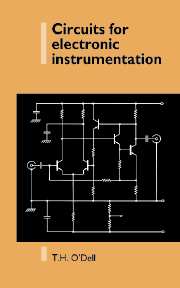Book contents
- Frontmatter
- Contents
- Preface
- 1 Circuits for electronic instrumentation
- 2 Sampling pulse generator circuits
- 3 Sample and hold circuits
- 4 Comparator circuits
- 5 Probes and input circuits
- 6 Wide-band amplifier circuits
- 7 Waveform generator circuits
- 8 Switched capacitor circuits
- 9 Phase locked loop circuits
- 10 Low noise circuits
- Name index
- Subject index
4 - Comparator circuits
Published online by Cambridge University Press: 05 June 2012
- Frontmatter
- Contents
- Preface
- 1 Circuits for electronic instrumentation
- 2 Sampling pulse generator circuits
- 3 Sample and hold circuits
- 4 Comparator circuits
- 5 Probes and input circuits
- 6 Wide-band amplifier circuits
- 7 Waveform generator circuits
- 8 Switched capacitor circuits
- 9 Phase locked loop circuits
- 10 Low noise circuits
- Name index
- Subject index
Summary
The analog to digital converter (ADC)
The sub-system which follows the sample and hold circuit, and its sampling pulse generator, in a digitising oscilloscope will be an ADC. In this particular case, the function of the ADC is to convert the output from the sample and hold circuit, which is an analog signal carried by a single channel, into a digital representation of this analog signal, carried in parallel by, typically, eight lines. An eight bit representation would be only just adequate for a digitising oscilloscope because this would give 256 discrete levels, meaning that a vertical display, 8 cm high, would have a vertical resolution of about 0.3 mm. This is about the same as a typical CRO spot diameter. More bits would be needed to handle the display offset, the sign of the signal, and the sensitivity range, but only the circuit problems of the ADC are considered in this chapter.
ADCs are not only found in digitising oscilloscopes. Any instrumentation problem that calls for an interface between a transducer or a sensor, nearly all of which give out an analog signal, and a digital computer, will call for an ADC. There is also another field of application, as Gordon [1] has pointed out in an important review. This is the field of communications where digital techniques are taking over more and more, in telephony and in television.
- Type
- Chapter
- Information
- Circuits for Electronic Instrumentation , pp. 46 - 71Publisher: Cambridge University PressPrint publication year: 1991



